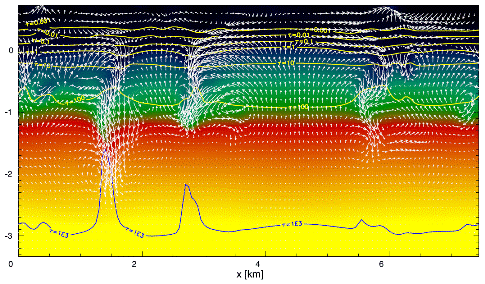| First 3-Dimensions atmosphere models for white dwarfs |
| 2011-08-12 |
 A team of astrophysicists from Quebec and Germany, led by members of the CRAQ at the Université de Montréal, resolved a 20-years old challenge for the study of white dwarfs stars. White dwarfs are "dead" stars, with a core that stopped producing energy via thermonuclear reactions, like normal stars do. They are very compact object with a mass comparable to that of our Sun, but with a size comparable to the Earth. As a consequence, they are extremely dense and the gravity on their surface is more than 100 000 larger than on the surface of the Earth. A team of astrophysicists from Quebec and Germany, led by members of the CRAQ at the Université de Montréal, resolved a 20-years old challenge for the study of white dwarfs stars. White dwarfs are "dead" stars, with a core that stopped producing energy via thermonuclear reactions, like normal stars do. They are very compact object with a mass comparable to that of our Sun, but with a size comparable to the Earth. As a consequence, they are extremely dense and the gravity on their surface is more than 100 000 larger than on the surface of the Earth.
By comparing spectroscopy observations from telescopes to predictions from theoretical models, researchers can determine several characteristics of white dwarfs stars, and in particular, their surface temperature and mass, two important parameters helping astrophysicists to understand the evolution of our Galaxy. However, until now, this method was resulting in mass measurements for the coolest white dwarfs larger by about 20%. This was in complete contradiction with our understanding of stellar evolution. No plausible explanation could elucidate this discrepancy.
The research group composed of researchers from the CRAQ and from Germany, led by Pier-Emmanuel Tremblay (PhD graduate from Université de Montréal, under the supervision of Prof. Pierre Bergeron, and now post-doctoral fellow at the University of Heidelberg in Germany), solved this long-standing problem by calculating the first 3D atmospheric models for white dwarfs. The atmosphere of a star corresponds to the surface layers emitting the light that we observe from Earth. The 3D numerical simulations implemented by the researchers are treating precisely the energy transfer throughout the atmosphere as well as the time evolution of convective motion of gas bubbles moving near the surface of white dwarfs. Previous 1-dimensional models used to describe the atmosphere of white dwarfs were modeling convective motion of matter inside the stars in a very simplistic manner. While the old 1D models are overestimating the mass of white dwarfs, the new 3D atmospheric model calculation lead to mass measurements in perfect agreement with the stellar evolution predictions for white dwarfs.
This work is presented in the European journal "Astronomy and Astrophysics" in July, and the article is also among the highlights of the journal.
The illustration above represents a slice of the atmosphere of a white dwarf, as described by the 3D models.
|

 A team of astrophysicists from Quebec and Germany, led by members of the CRAQ at the Université de Montréal, resolved a 20-years old challenge for the study of white dwarfs stars. White dwarfs are "dead" stars, with a core that stopped producing energy via thermonuclear reactions, like normal stars do. They are very compact object with a mass comparable to that of our Sun, but with a size comparable to the Earth. As a consequence, they are extremely dense and the gravity on their surface is more than 100 000 larger than on the surface of the Earth.
A team of astrophysicists from Quebec and Germany, led by members of the CRAQ at the Université de Montréal, resolved a 20-years old challenge for the study of white dwarfs stars. White dwarfs are "dead" stars, with a core that stopped producing energy via thermonuclear reactions, like normal stars do. They are very compact object with a mass comparable to that of our Sun, but with a size comparable to the Earth. As a consequence, they are extremely dense and the gravity on their surface is more than 100 000 larger than on the surface of the Earth.